

All About Asking Better Questions. Asking questions is such a basic tool of teaching, yet how many of us have ever been taught to ask good questions?
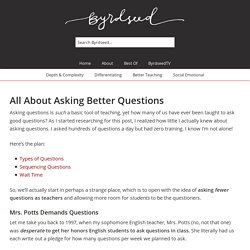
As I started researching for this post, I realized how little I actually knew about asking questions. I asked hundreds of questions a day but had zero training. I know I’m not alone! Here’s the plan: So, we’ll actually start in perhaps a strange place, which is to open with the idea of asking fewer questions as teachers and allowing more room for students to be the questioners. Mrs. Let me take you back to 1997, when my sophomore English teacher, Mrs. Why would a teacher have such a hard time getting her advanced 10th graders to ask a darn question? How to make good arguments at school (and everywhere else) From as early as Grade 3 teachers start teaching children how to put across their own points of view.
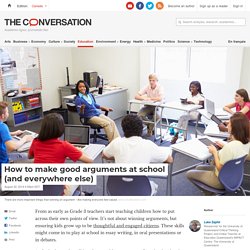
Deeper Class Discussions with the TQE Method. Edutopia. As a former middle school special education teacher and current tutor of middle and high school students, I often work with older children who struggle immensely with reading and writing tasks. Edutopia. The Complete Guide to Remembering What You Read. Edutopia. Common Core in Action: 10 Visual Literacy Strategies.
Do you wish your students could better understand and critique the images that saturate their waking life?
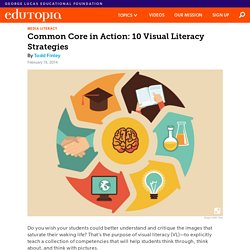
That's the purpose of visual literacy (VL), to explicitly teach a collection of competencies that will help students think through, think about and think with pictures. Standards Support Visual Literacy Instruction Visual literacy is a staple of 21st century skills, which state that learners must "demonstrate the ability to interpret, recognize, appreciate and understand information presented through visible actions, objects and symbols, natural or man-made. " Putting aside the imperative to teach students how to create meaningful images, the ability to read images is reflected in the following standards. Common Core State Standards (CCSS) CCSS.ELA-Literacy.RH.6-8.7: "Integrate visual information (e.g., in charts, graphs, photographs, videos or maps) with other information in print and digital texts.
" How to Teach Visual Literacy: Visual Thinking Routines. Anticipation Guides. Classroom Strategies Download a Graphic Organizer Blank Anticipation Guide Word Doc (120 KB)PDF (125 KB) Background.

ASCD Express 13.03 - Five Ways to Intentionally Support Reading Independence. Thinking about Thinking: The Power of Noticing. A Skill Strong Readers Share. Students in classrooms across the United States spend an estimated 85 percent of their school day on assignments that require reading texts.
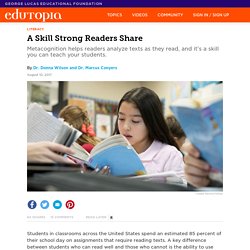
A key difference between students who can read well and those who cannot is the ability to use metacognition. Metacognition can be regarded as a conversation readers have with themselves about what they are reading. Metacognitive readers enjoy reading because they can find meaning in texts and think deeply to comprehend what they’re reading. Those who have not yet learned to be metacognitive often have trouble reading fluently and comprehending what they read. Virtually all students can learn how to become metacognitive readers when they are explicitly taught. Before Reading We consider the prereading stage to be of critical importance.
6 Techniques for Building Reading Skills—in Any Subject. As avid lovers of literature, teachers often find themselves wanting to impart every bit of knowledge about a well-loved text to their students.
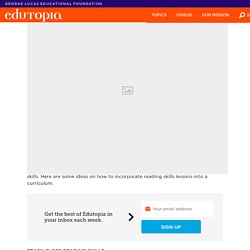
And this is not just an ELA issue—other disciplines also often focus on the content of a text. However, teaching reading skills in English classes and across the disciplines is an almost guaranteed way to help students retain content. Unfortunately, the tendency to focus on the content is a real enemy to the ultimate goal of building reading skills. Teaching Adolescents How to Evaluate the Quality of Online Information.
An essential part of online research is the ability to critically evaluate information. This includes the ability to assess its level of accuracy, reliability, and bias. In 2012, my colleagues and I assessed 770 seventh graders in two states to study these areas, and the results definitely got our attention. Unfortunately, over 70 percent of the students’ responses suggested that: 4 Strategies to Model Literary Analysis. A line from Umberto Eco’s Six Walks in the Fictional Woods, “Every text, after all, is a lazy machine asking the reader to do some of its work,” speaks directly to the beauty and challenge behind teaching literary analysis.
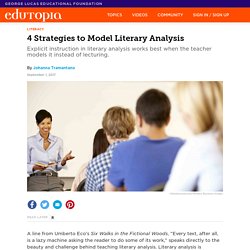
Literary analysis is something we must do, not something the text does for us, which is why students must actively learn strategies for it. There are a number of strategies teachers can use to support literary analysis in the classroom. Direct, explicit instruction is one example that can be beneficial to the process. In Explicit Instruction: Effective and Efficient Teaching, Anita Archer and Charles Hughes define explicit instruction as a structured, systematic, and effective approach to teaching skills. Critical reasoning for beginners. Evaluating Sources in a ‘Post-Truth’ World: Ideas for Teaching and Learning About Fake News - The New York Times. Back in 2015, when we published our lesson plan Fake News vs. Real News: Determining the Reliability of Sources, we had no way of knowing that, a year later, the Oxford Dictionaries would declare “post-truth” the 2016 word of the year; that fake news would play a role in the 2016 presidential election; that it would cause real violence; and that the president-elect of the United States would use the term to condemn mainstream media outlets he opposes.
Back then, to convince teachers that the skill was important, we quoted Peter Adams of the News Literacy Project on the “digital naïveté” of the “digital natives” we teach. Now, however, we doubt that we need to convince anyone. These days, invented stories created in a “fake news factory”— or by a 23-year-old in need of cash — go viral, while articles from traditional sources like The Times are called “fake news” by those who see them as hostile to their agenda. As always, we welcome your ideas; please post them in the comments. Mr. TIP Online Think-Aloud Lessons. Talking About Reading As Thinking: Modeling the Hidden Complexities of Online Reading Comprehension* by Julie Coiro, University of Rhode Island Companion website to Coiro, J. (2011).
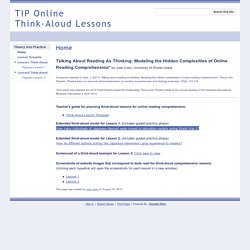
Talking about reading as thinking: Modeling the hidden complexities of online reading comprehension. Theory Into Practice: Themed issue on new and critical perspectives on reading comprehension and strategy instruction, 50(2), 107-115. *This article was awarded the 2012 Frank Pajares Award for Outstanding Theory Into Practice Article at the annual meeting of the American Educational Research Association in April, 2012. 7 Strategies For Using Context Clues In Reading - 7 Strategies For Using Context Clues In Reading.
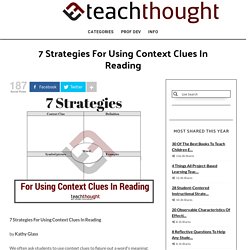
Teaching Theme using Close Reading Strategies. Upper Elementary Snapshots: Citing Text Evidence in 6 Steps. Knowing the answer is one thing...but being able to justify your thinking by citing text is an entirely different type of skill.
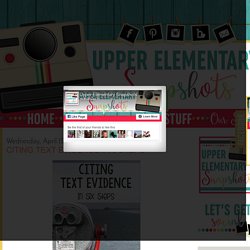
Taking the text and combing through it, like an old man at the beach with a metal detector, determined to find some treasures, not only takes strong reading comprehension skills, but also takes some perseverance, to find what we're looking for.Here are the six steps I use in my classroom, to teach this important reading skill: 1. Teach the Specific Steps to Cite Text Evidence. Understanding Close Reading: Download our Infographic Now! - WeAreTeachers.
Teach the Seven Strategies of Highly Effective Readers. By: Elaine K. McEwan To improve students' reading comprehension, teachers should introduce the seven cognitive strategies of effective readers: activating, inferring, monitoring-clarifying, questioning, searching-selecting, summarizing, and visualizing-organizing. This article includes definitions of the seven strategies and a lesson-plan template for teaching each one. Coffee Cups and Lesson Plans. How to Teach Analysis Like a Boss – The Rhetor's Toolbox. How to Read a Book: The Ultimate Guide by Mortimer Adler. Edutopia. Educational Technology and Mobile Learning: Here Is A Great Reading App for Research Students. June 8, 2017 LiquidText is a good app to help you enhance your reading. It provides you with a virtual workspace where you can manage, organize and work on your documents. More specifically, it lets you import documents (compatible with Word, PDF, and PowerPoint) and web pages right into your workspace, you can exact excerpts and key facts from your documents and draw or add your own notes.
Critical assignment #1 reading strategies. Engage Readers and Increase Comprehension: Annotate Text. Teaching Students To Analyze Complex Texts Infographic. Teacher Infographics. 6 Techniques for Building Reading Skills—in Any Subject.